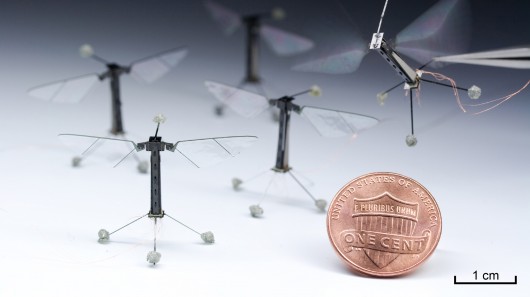Harvard's flying robot insect can now hover and steer
May 8, 2013

Harvard's RoboBees could one day work together in search and rescue operations (Photo: Kevin Ma and Pakpong Chirarattananon)
Almost since the beginning of their existence, robots have taken inspiration from one of nature's wonders: insects. Technological limitations typically prevents robots from matching the size of their many-legged muses, resulting in larger-than-life examples like Festo's BionicOpter dragonfly. In stark contrast is Harvard's RoboBee, which is the first in the world to demonstrate controlled flight by an insect-sized winged robot.
When we looked at the RoboBee last year, it was only able to fly for a few seconds before crashing. Now, the robot can hover and move along a preset flight path. "This is what I have been trying to do for literally the last 12 years," says Robert J. Wood, Professor at the Harvard School of Engineering and Applied Sciences (SEAS), and team leader on the RoboBee project.
In a nutshell, it has taken more than a decade because "size matters." The robot's body measures just 2 centimeters (0.8 inch) in length and weighs 80 milligrams, so even minor changes in air flow can knock the robot off balance.
Additionally, manufacturing dozens of prototypes at this scale was only made possible through a novel technique developed by Wood's team at SEAS. Flat layers of laser-cut carbon fiber, hinged together with embedded plastic, are folded into three-dimensional frames rather than piecing it together by hand. In practice it works much like the pages of a pop-up book, reducing the complexity and time required in the build process.
Motorization presented another problem. With a wingspan of 3 cm, typical motors were simply too cumbersome. "Large robots can run on electromagnetic motors, but at this small scale you have to come up with an alternative, and there wasn't one," says co-lead author Kevin Y. Ma, a graduate student at SEAS.
The team adopted piezoelectric actuators (thin strips of ceramic that expand and contract under an electric field) to serve as the wing muscles, which beat independently 120 times per second. This allowed the team to control the robot's rotation mid-flight. "Now that we’ve got this unique platform, there are dozens of tests that we’re starting to do, including more aggressive control maneuvers and landing," says Wood.
Watch the flight of the RoboBee:
Currently the RoboBee relies on external sources for power and control since these have yet to be miniaturized, but eventually the Harvard team plans to produce self-contained units. These could then work together in artificial colonies to monitor the environment, pollinate crops, and perform search and rescue or espionage missions. And, as seen with the manufacturing process, any technological innovations developed along the way are valuable in and of themselves.
"I want to create something the world has never seen before," says Kevin Y. Ma, graduate stuent at SEAS and co-lead author of a paper published last week in Science. "It’s about the excitement of pushing the limits of what we think we can do, the limits of human ingenuity."
Even if it takes them another 12 years or more to complete the RoboBee, the Harvard team has already done that.
Source: Harvard University
Copyright © gizmag 2003 - 2013 To subscribe or visit go to: http://www.gizmag.com
http://www.gizmag.com/harvard-robobee-flying-robot-insect/27432